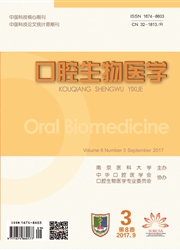

 中文摘要:
中文摘要:
目的:对一种新型生物可降解聚碳酸丁二醇酯(poly butylene carbonate,PBC)电纺膜的生物相容性进行研究。方法:以聚己内酯(polycaprolactone,PCL)电纺膜为对照,检测2种膜的表面接触角,然后分别在其上接种MC3T3-E1细胞,使用场发射扫描电子显微镜对电纺膜的原始形貌和接种细胞1d后的形貌进行表征,使用甲基噻唑基四唑(MTT)比色法和碱性磷酸酶(alka-line phosphatase,ALP)活性法检测电纺膜对测试细胞增殖和分化的影响。结果:PBC电纺膜的接触角值低于PCL电纺膜,且差异显著(P〈0.05);接种1d后细胞在两种电纺膜的表面都铺展良好,结合紧密;PBC电纺膜和PCL电纺膜对细胞增殖活性的影响在1d和7d都没有显著差异(P〉0.05);接种7d时,PBC电纺膜组的ALP活性高于PCL电纺膜组,且差异显著(P〈0.05)。结论:与电纺PCL膜相比,电纺PBC膜在亲水性和促进细胞分化方面性能更佳,可以进一步研发其在生物医学领域的应用。
 英文摘要:
英文摘要:
Objective:To study the biocompatibility of a new kind of biodegradable poly butylene carbonate (PBC) electrospun film. Methods:Polyeaprolactone (PCL) electrospun membranes were prepared as control. Contact angles on the surfaces of two kinds of films were tested. Cell line MC3T3-E1 was seeded onto both kinds of membranes. SEM images were taken to characterize the original morphology of eleetrospun films and cells one day after seeding. MTT and ALP tests were performed to test the influence of electro- spun films on proliferation and differentiation of tested cells. Results : Contact angles in PBC group were lower than those in PCL group, and the difference was significant ( P 〈 0.05 ). One day after seeding, ceils attached tightly with both PBC and PCL membranes and spread well on them. There were no significant differences in effects on cell proliferation between two kinds of membranes on the 1 st and 7th day (P 〉 0.05 ) , while ALP values in PBC group were significantly higher than those in PCL group on the 7th day (P 〈 0.05 ). Conclusions:Compared with PCL films, PBC films were a little better in hydrophilieity and cell differentiation, and can be further studied for biomedical use.
 同期刊论文项目
同期刊论文项目
 同项目期刊论文
同项目期刊论文
 期刊信息
期刊信息
